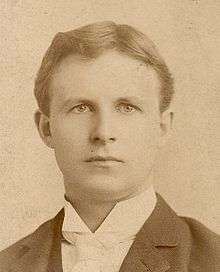George Rice Carpenter
George Rice Carpenter (October 25, 1863 – April 8, 1909) was a noted educator, scholar and author. He was a descendant of the Rehoboth Carpenter Family and Edmund Rice of Massachusetts.
George Rice Carpenter | |
|---|---|
 | |
| Born | 25 October 1863 |
| Died | 8 April 1909 (aged 45) |
| Nationality | American |
| Citizenship | American |
| Occupation | educator, scholar and author |
| Years active | 1886–1909 |
| Known for | educator, scholar and author |
| Spouse(s) | Mary Seymour |
| Parent(s) | Rev. Charles C. Carpenter & Nancy Feronia Rice |
| Relatives | Margaret Seymour Carpenter, daughter and author |
Early life and education
His father was Charles Carrol Carpenter (born 1836) and mother was Nancy Feronia Rice (b. 1840). His father was a Congregational minister who left an account of the final days of the Civil War and was an eyewitness of Abraham Lincoln's entry into Petersburg, Virginia.[1]
George Rice Carpenter was born at the Eskimo River Mission Station on the Labrador Coast where his parents were engaged in pioneer missionary service.[2] After attending Phillips Academy, Andover, Carpenter entered Harvard where he graduated in 1886.
Academic career
Carpenter became a Harvard instructor in 1888 and assistant professor at MIT until 1893. Carpenter then became a professor and chairman of English rhetoric at Columbia University in New York where he remained for the duration of his life. He died in New York City in 1909 and was the subject of several articles in salutation. A library at Columbia is jointly named in his honor.[2]
Family of authors
Carpenter married Mary Seymour of New York in 1890. Carpenter's daughter Margaret Seymour Carpenter (Margaret Carpenter Richardson) (b. 3 April 1893 - d. 1973) was herself the author of several short stories[3] and the novel Experiment Perilous, Little Brown & Co., Boston. (1943).[2][4][5] George Rice Carpenter's publications were copious. A large number of textbooks were from his hand. Carpenter produced works on Longfellow (1901), Whittier (1903), Whitman (1909), among others listed in the next sections.[2]
Books
- Carpenter, George Rice. American Prose: Selections with Critical Introductions by Various Writers and a General Introduction, Macmillan, 1898.
- Brewster, William Tenney and Carpenter, George Rice. Studies in Structure and Style, Macmillan, 1898.
- Carpenter, George Rice. Walt Whitman, Macmillan, 1909.
- Carpenter, George Rice. John Greenleaf Whittier, Houghton, Mifflin and Co., 1909.
- Carpenter, George Rice. The Episode of the Donna Pietosa, 1889.
- Carpenter, George Rice, Baker, Franklin J, Scott, Fred N. The Teaching of English in the Elementary and the Secondary School, Longmans, Green & Co. 1903.
- Carpenter, George Rice, Baker, Franklin Thomas, Owens Jennie Freeborn. Language Reader, Macmillan, 1909.
Articles referencing subject
- Brewster, William T. Columbia University Quarterly, June 1909.
- Fletcher, Jefferson B. Annual Report of the Dante Society, 1909, pp. 7–9.
- Steeves, R. Columbia University Quarterly (extensive bibliography), September 1909.
Genealogy
George Rice Carpenter was a descendant of Edmund Rice, an English immigrant to Massachusetts Bay Colony, as follows:[6]
- George Rice Carpenter, son of
- Nancy Feronia Rice (1840 – ?), daughter of
- Ezra Rice (1810 – ?), son of
- Edward Rice (1773 – ?),[7] son of
- Comfort Rice (1729 – 1816), son of
- Lt. Gershom Rice, Jr. (1696 – 1781), son of
- Gershom Rice (1667 – 1768), son of
- Thomas Rice (1625 – 1681), son of
- Edmund Rice (1594 – 1663)
His Carpenter ancestry includes:[1]
- George Rice Carpenter son of
- Rev. Charles Carroll Carpenter (1836 – ?), son of
- Dr. Elijah Woodward Carpenter (1788 – 1855), son of
- John Carpenter (1756 – 1843), son of
- John Carpenter (1733 – 1821), son of
- David Carpenter (1701 – 1787), son of
- David Carpenter (1675 – 1701), son of
- Samuel Carpenter (1638 – 1682), son of
- William Carpenter (abt 1605 – 1658), the immigrant.
See also
References
- Carpenter, Amos B. A Genealogical History of the Rehoboth Branch of the Carpenter Family in America, Amherst Massachusetts, 1898. He is number 7693 on page 732 of the book and his family is on page 755 as # 1560.
- Johnson, Allen, "Dictionary of American Biography", Vol. 2, page 511.
- "Margaret Carpenter (1893 -1973)". Fiction Magazine Index. Archived from the original on 7 December 2009. Retrieved 11 December 2009.
- United States Census of 1900, Manhattan, New York 1:567:sheet 9
- "Carpenter-Richardson Family Papers 1880-1972". Washington State University Libraries. Retrieved 24 March 2010.
- Edmund Rice (1638) Association, 2007. Descendants of Edmund Rice: The First Nine Generations.
- "Edward Rice". Edmund Rice (1638) Association. Retrieved 2 July 2010.